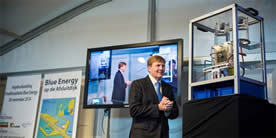Blue energy is perhaps the energy of the future. Sources such as the sun, wind, and tidal power are already well-known for delivering green energy. Could Blue-energy be the next renewable energy?
Renewable energy is an important topic in a world where oil, natural gas, coal, and uranium have an expiration date whilst the demand for energy is rising. Renewable energy sources such as the sun, wind, and tidal power are already well-known alternatives to keep supply and demand in accordance in the future, but now there’s another, still relatively unknown way to produce energy: blue-energy. The technique was already discovered a couple of decades ago, yet the process seemed to be not really worthwhile, until recently.
Researchers from Utrecht University in The Netherlands not so long ago announced to have discovered a way to triple the energy produced from blue-energy plants. This is a real breakthrough, and has led to renewed interest in blue-energy plants as a possible source to meet large-scale energy demands. Valve World dived into the matter to explore the topic.
Blue-energy?
Blue-energy is generated where fresh water and salt water meet. There are multiple ways to generate energy out of this, but we’ll stick to the way that is used in the test plant in The Netherlands, for this method seems to be very promising. At a site where a river flows into the sea you have the perfect spot to build a blue-energy power plant and this is exactly what has been done in The Netherlands. At the end of 2014, his Majesty King Willem-Alexander officially opened the first blue-energy power plant at the 'Afsluitdijk', in the north of the country. For this test plant the Research Institute MESA+ from the University of Twente provided much knowledge. In the test plant a technique is used that is based on eight years of work. The research is of course continued and extensively tested in the plant. To get a better understanding of what exactly is being researched, let’s have a closer look at the method behind blue-energy.

photo: Frank van Beek; source: www.koninklijkhuis.nl
So how does it work?
At the pilot installation in The Netherlands, fresh water from the inland sea IJsselmeer and salt water from the Wadden Sea is collected, stored, and filtered separately. In the next step a membrane is put between these two sorts of water. The salt water contains many more ions – charged particles that want to travel to fresh water. The membrane functions as a coffee filter, but then exactly the other way around: the water is stopped, while ions are allowed to pass through. In order to generate power, two sorts of membrane are used. One filters the natrium, and the other chloride, thus creating positively charged water on one side and negatively charged water on the other, which is then comparable to a battery, with one side positively, and the other side negatively charged.
Further research
The recent discovery Utrecht University did is that by pre-heating the incoming fresh water the potential energy outcome can be tripled, which effectively means that it would be possible to provide one-third of The Netherlands of energy. In addition, researchers from Nijmeijer’s Membrane Science and Technology department are making fast progress in optimizing the membranes. Two researchers already obtained their Doctoral Degree in this field: Enver Güler developed a membrane that yields the highest energy to date, and David Vermaas optimized the way to let water pass through the membranes. Two new PhD candidates are currently working onwards from these developments.
The next step?
Making any predictions is difficult, with the current low oil and gas prices. However, the future seems to look pretty bright for blue-energy. The considerable progress that has been made and the further research that is being conducted, indicate that blue-energy could very well become one of our major sources of renewable energy, which means lots of possibilities for valve manufacturers as well. At Valve World we think it is not so much a question of if, but rather when. Therefore we will definitely keep a close eye on the matter. |